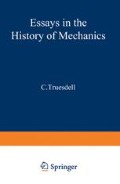Abstract
That matter is composed of molecules in violent agitation, and that heat is a manifestation of that motion, are ideas of great age. The first definite measure of the heat of intestine motion was proposed by Hermann in 17161.
Access this chapter
Tax calculation will be finalised at checkout
Purchases are for personal use only
Preview
Unable to display preview. Download preview PDF.
Literatur
Daniel Bernoulli is one of the most mysterious figures in the history of science, mysterious for no other reason than that nobody troubles to study through his works, while historians continue to attribute to him fame or blame for things he did not do or say. Much of the passage on the kinetic theory is printed in English translation in W. F. Magie’s A Source Book of PhysicsMcGraw-Hill, 1938, pp. 247–251; most of it, in an inaccurate English version by J. P. Berryman, is included in Kinetic Theory1 (ed. S. G. Brush), Pergamon Press, 1965. A German translation, with a note by P. du Bois-Reymond, was published in the Annalen der Physik 107=(4) 17490–494 (1859) and by A. Speiser, pp. 139–143 of Klassische Stücke der MathematikZürich and Leipzig, 1925.
R. J. Boscovich, Theoria Philosophiae Naturalis., Vienna, 1758. I have consulted only the revised edition of 1763, republished, with an English translation, by -J. M. Child, Open Court, 1922. Beyond that fact that Kelvin cited Boscovich as a predecessor in atomics, quite evidently only so as to make a generous gesture toward the past and without owing anything from his reading (if any) of what Boscovich wrote, I am unable to find any influence, let alone concrete achievement, in the treatise of the learned Slovenian Jesuit.
J. Herapath, “ On the physical properties of gases,” Annals of Philos(1) 8, 56–60 (1816).
J. P. Joule, “Some remarks on heat and on the constitution of elastic fluids” (1848), Mem. Manchester Lit. Phil. Soc9, 107–114 (1851)= (with added notes) Phil. Mag(4) 14, 211–216 (1857) = Papers1, 290–297.
A. Krönig, “Grundzüge einer Theorie der Gase,” Annalen der Physik99= (4) 9, 315–322 (1856).
J. J. Waterston, “On the physics of media that are composed of free and perfectly elastic molecules in a state of motion” (abstract), Proc. R. Soc. London5, 604 (1846) = Phil. Trans. R. Soc. LondonA 18378 (1893)= Papers 317-318. This abstract can scarcely have been composed by Waterston himself.
Waterston, “On a general theory of gases,” Rep. Brit. Assn. Adv Sci1851, 6= Phil. Trans. R. Soc. LondonA 18379 (1893)= Papers318-319.
Waterston, “ The physics of media that are composed of free and perfectly elastic molecules in a state of motion” (with an introduction and notes by Lord Rayleigh), Phil. Trans. R. Soc. LondonA 1831–79 (1893) = Papers207-331.
Waterston, Props. I and II of “Note on the physical constitution of gaseous fluids and a theory of heat,” at the end of Thoughts on the Mental FunctionsEdinburgh, 1843 = Papers183-206. Of course, nobody could be blamed for not noticing something published so obscurely, but the moguls of science cannot have it bothways, advising the youngsters with original thoughts both to keep out of major journals andto gain their initial recognition by publishing in pages nobody reads.
S. G. Brush, “The development of the kinetic theory of gases, I. Herapath,” Annals of Science 13, 188–198 (1957).
The Royal Society’s first rejection of the kinetic theory of gases (1821), John Herapath versus Humphry Davy, Notes and Records of the Royal Society of London18, 161–180 (1963). “Foundations of statistical mechanics 1845–1915,” Arch. Hist. Exact Sci4,145–183 (1967).
Cfalso E. Mendoza: “A sketch for the history of the kinetic theory of gases,” Physics Today14, 36–39 (1961). “The surprising history of the kinetic theory of gases,” Mem. Manchester Lit. Phil. Soc105, 1–14 (1962/3).
Rights and permissions
Copyright information
© 1968 Springer-Verlag Berlin Heidelberg
About this chapter
Cite this chapter
Truesdell, C. (1968). Early Kinetic Theories of Gases. In: Essays in the History of Mechanics. Springer, Berlin, Heidelberg. https://doi.org/10.1007/978-3-642-86647-0_6
Download citation
DOI: https://doi.org/10.1007/978-3-642-86647-0_6
Publisher Name: Springer, Berlin, Heidelberg
Print ISBN: 978-3-642-86649-4
Online ISBN: 978-3-642-86647-0
eBook Packages: Springer Book Archive

